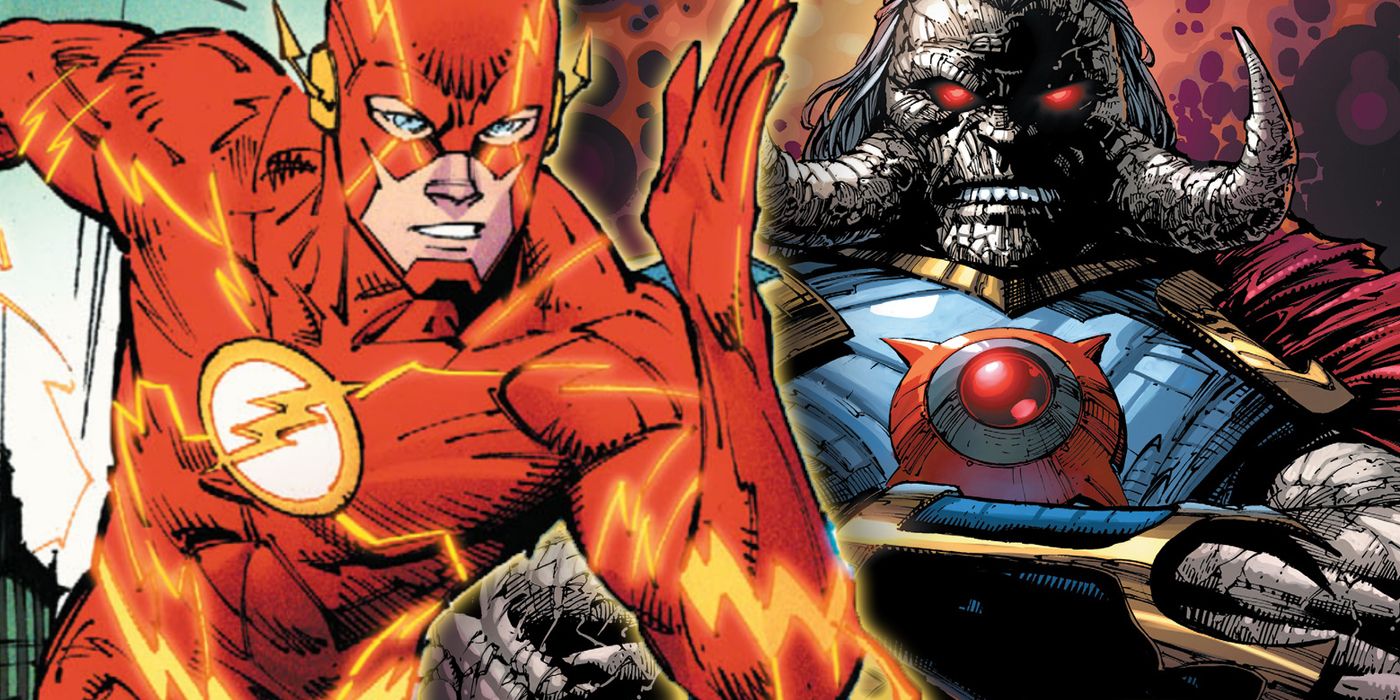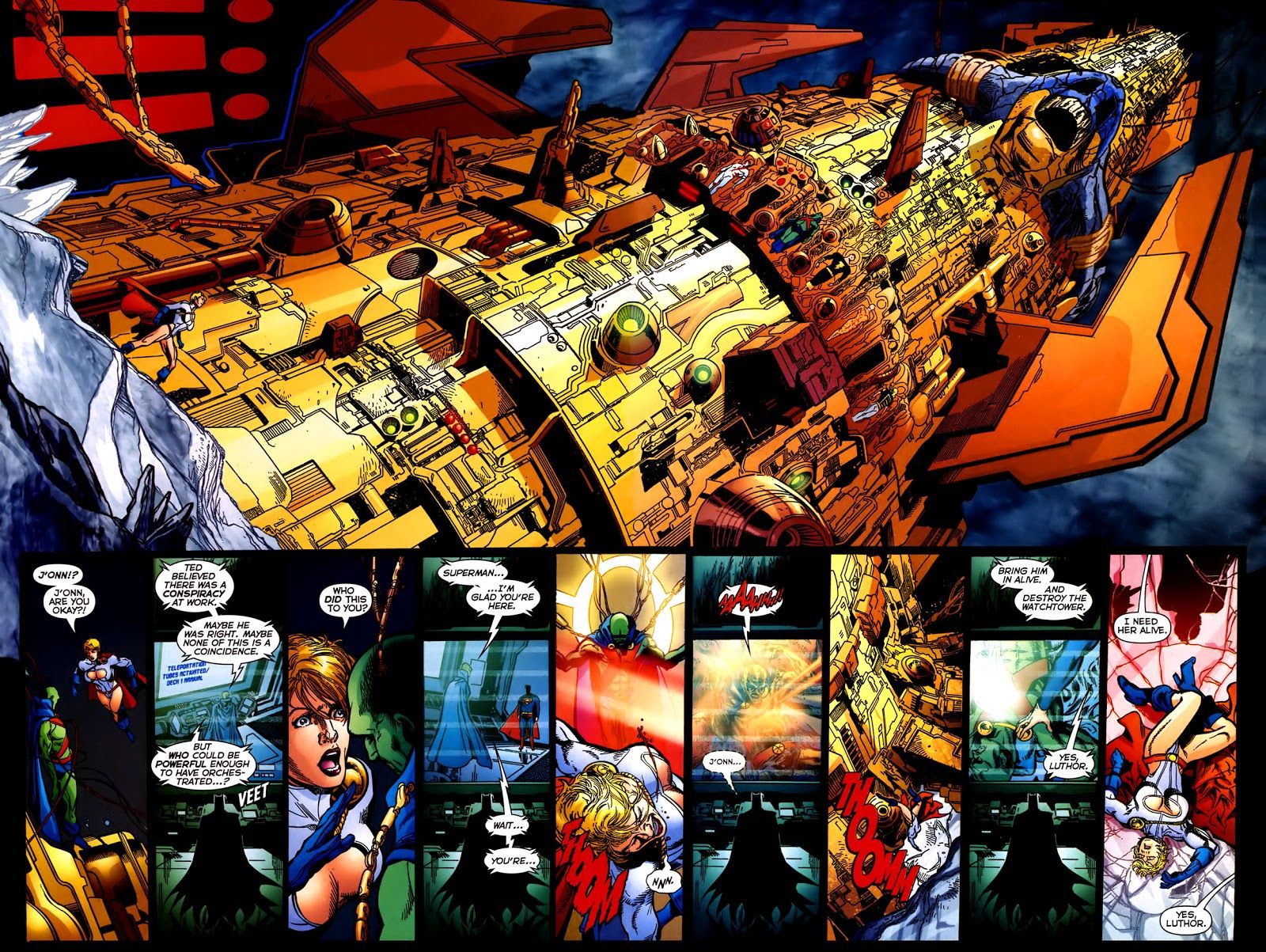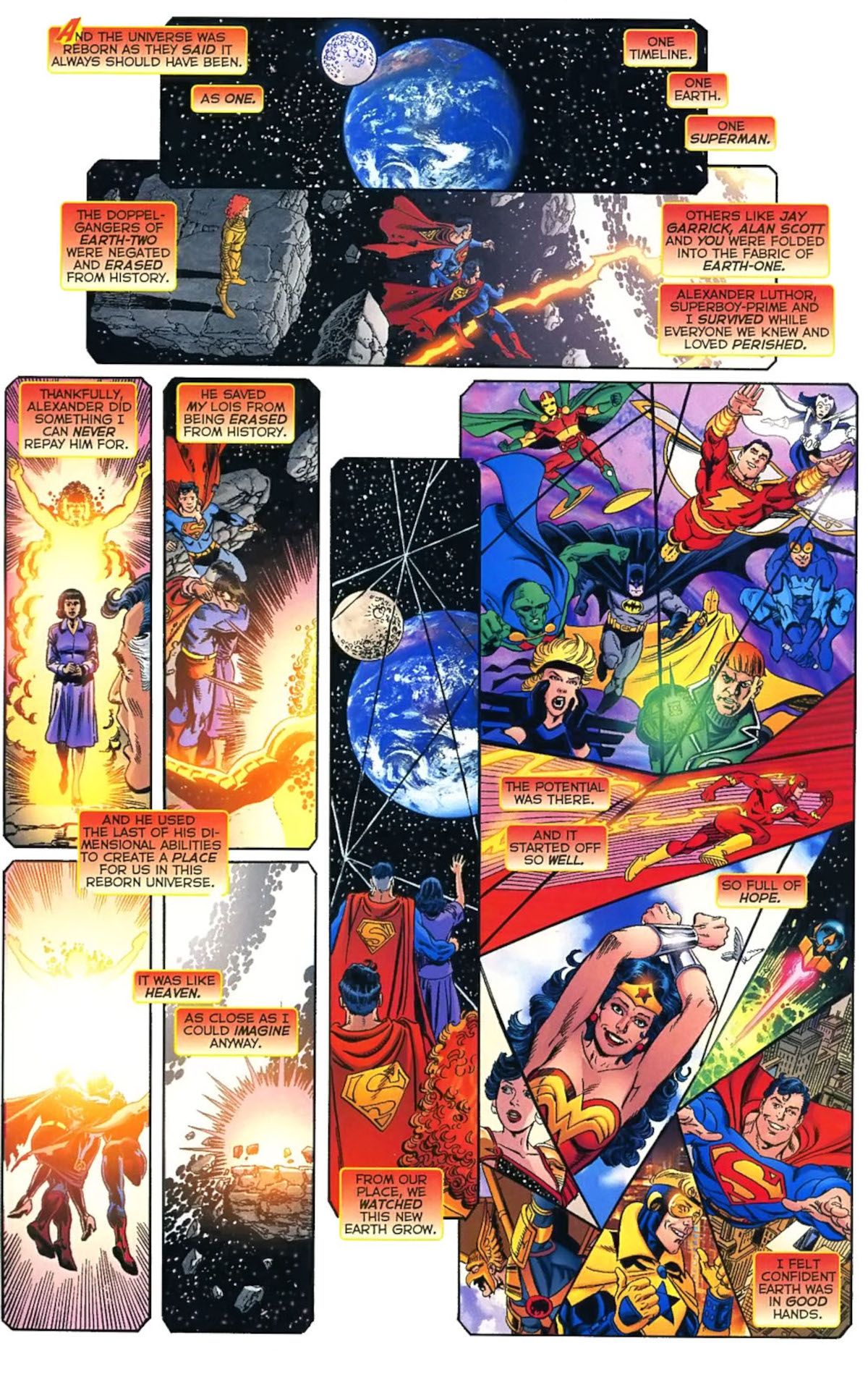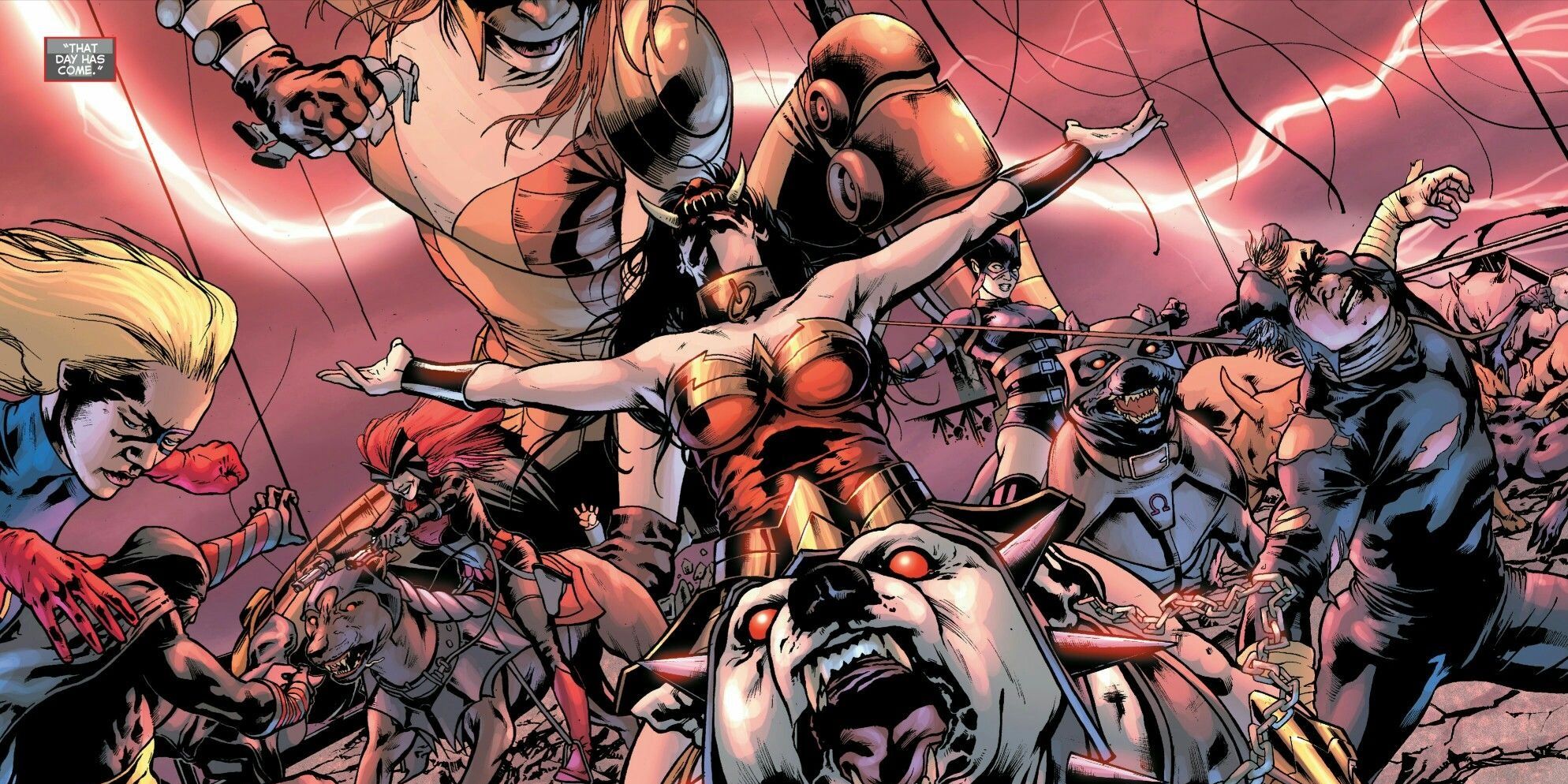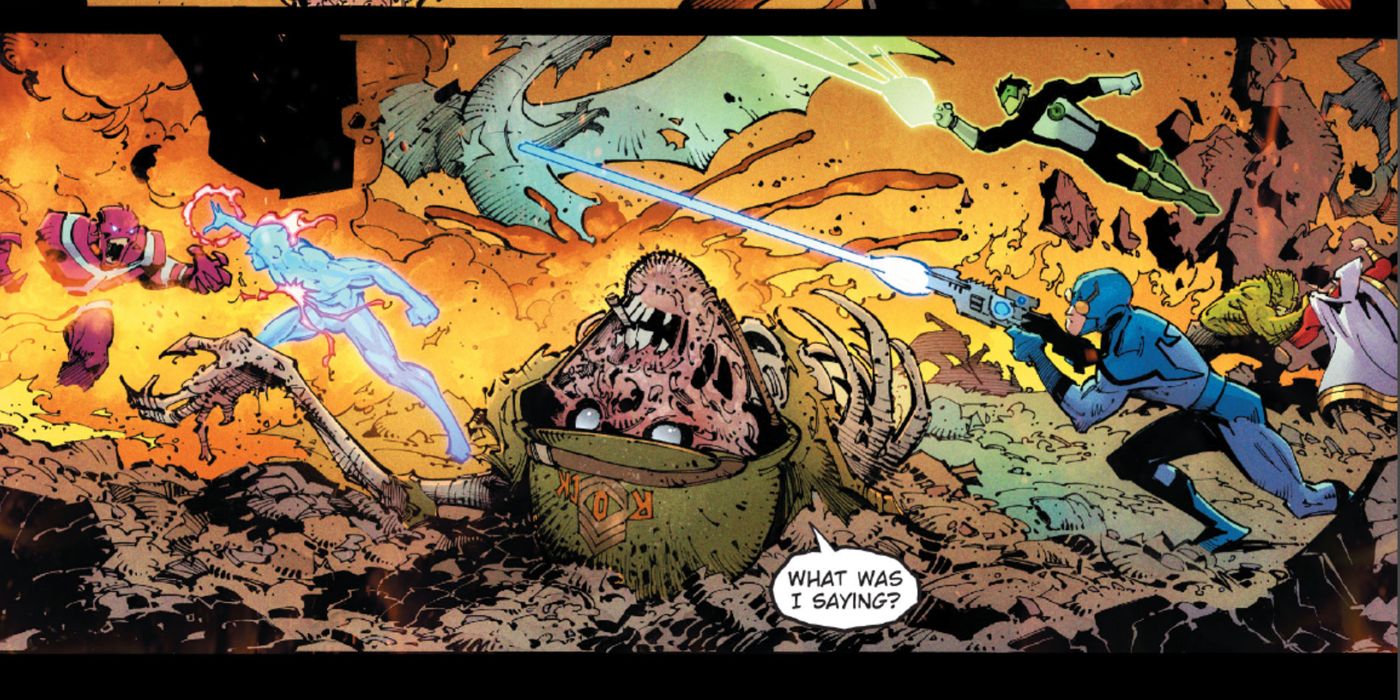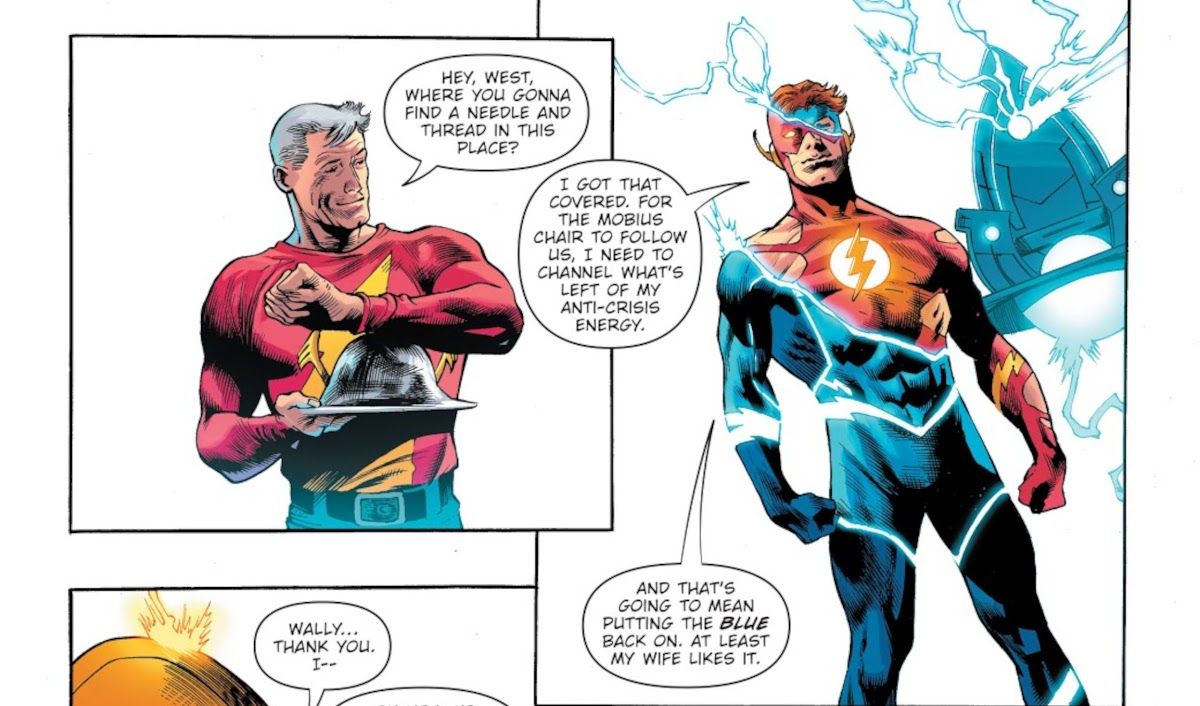WARNING: The following contains major spoilers for Dark Nights: Death Metal #4, by Scott Snyder, Greg Capullo, Jonathan Glapion, FCO Plascencia and Tom Napolitano, on sale now.
After taking September off, Dark Nights: Death Metal slams back into October with a vengeance. Of course, our heroes were pretty busy last month in specials like Death Metal: Trinity Crisis, Death Metal: Multiverse's End and Death Metal: Speed Metal but Death Metal #4 does a good job updating readers. We'll try to do the same, keeping you up-to-date on all the things we noticed as the miniseries heads past the halfway point. Therefore, grab your copy, prepare for SPOILERS, and buckle up!
Dark Nights: Death Metal #4 was written by Scott Snyder, penciled by Greg Capullo, inked by Jonathan Glapion, colored by FCO Plascencia, and lettered by Tom Napolitano. Jared Blando is credited as cartographer, while Darran Robinson designed the publication. The associate editor was Andrew Marino and the issue was edited by Marie Javins.
RELATED: Dark Nights: Death Metal #4 Annotated, Part 1: Crisis Tie-ins and Superboy-Prime
Catching Up With the Flash (Pages 9-10)
This issue picks up after the events of November 2020's Speed Metal special, an affectionate tribute to classic Wally West from writer Joshua Williamson and penciller Eddy Barrows. It showed how Wally, Wallace West, Barry Allen and Jay Garrick retrieved the Mobius Chair after the Batman Who Laughs had stolen it. Also, it established that Wally's family and allies including Bart "Impulse" Allen, Jesse Quick and Max Mercury are safe inside the Speed Force, and available to help when necessary.
We mentioned the Mobius Chair in the annotations for issue #1, but this is its Death Metal debut. Although June 2015's Justice League #40 revealed that Mobius the Anti-Monitor, had the chair first, it's most commonly associated with Metron of the New Gods. Jack Kirby created Metron and the Mobius Chair for February-March 1971's New Gods #1.
Meanwhile, Page 10 continues the Robin King's fight with Swamp Thing, Harley Quinn and Jarro from Trinity Crisis. In that issue, it looked like Jonah Hex's corpse had met a pretty final end, but there was still more hurt to inflict, as this issue proves.
Infinite Crisis (Pages 6-8, 13, 17)
After being introduced as a young Clark Kent who was a fan of the DCU, Superboy-Prime got to live his dream for about four issues before enduring 20 years of what he saw as DC's Earth in decline. That came to a head in 2005, when DC decided to celebrate COIE with a sequel. Infinite Crisis was written by Geoff Johns and pencilled mostly by Phil Jimenez, with help from George Pérez, Jerry Ordway, and Ivan Reis. It ran for seven issues from December 2005 to January 2006, but there was a lot of build-up and a whole lot of follow-up.
Turns out that the four COIE survivors – Superboy-Prime, Alexander Luthor and Earth-Two's Mr. and Mrs. Superman -- were not entirely happy with how DC-Earth turned out. Therefore, Luthor concocted a plan to remake the Multiverse so he could find a universe he liked. Building a massive device out of an old Monitor tuning fork and the Anti-Monitor's corpse, he captured other Multiversal representatives like Power Girl (Earth-Two) and Black Adam (Earth-S), because the machine would use their energies in connection with the Earth-Two Superman. As Alex noted in Infinite Crisis #5, "everything comes from Superman."
The machine worked and the Multiverse returned – but during the inevitable final battle the machine was destroyed, and the Earths recombined into a "New Earth" with elements of old continuity. After a couple more big super-battles, Superman, Wonder Woman and Batman were so wiped out that they took a whole year off. That year was chronicled in the weekly miniseries 52 (2006-07), which among other things revealed that there was a new DC Multiverse with 52 worlds in it.
Back at Death Metal #4, Alex Luthor's corpse (Page 6) is in the slot next to Wonder Woman's. Alex was the son of Earth-Three's greatest hero – it's the morally-reversed home of the Crime Syndicate – and his spouse Lois Lane. (She is not to be confused with the current Earth-3 Lois, who is the CS's Superwoman.) Alex was created by Marv Wolfman and George Pérez and first appeared in April 1985's Crisis On Infinite Earths #1. At the beginning of that issue, just before a wave of anti-matter destroyed Earth-Three, the Luthors rocketed their infant son to Earth-One where they hoped he'd be found and raised by the Justice League. However, the Monitor found baby Alex instead, and nurtured him as he grew quickly to young adulthood. Alex's trip across dimensions gave him plot-convenient cosmic powers, which he used to help defeat the Anti-Monitor and then, 20 years later, to restore the Multiverse. The Joker killed him in Infinite Crisis #7.
On Page 7, Superboy-Prime notes that he's been "listening" to the main DC-Earth. He's done a lot of that, both in exile and presumably since he's been free from the Source Wall (as alluded to on Page 8). Similarly, Page 7's reference to "the ugliest music in the universe" is appropriate on a couple of levels. Obviously music is a big motif in this miniseries, as it was in Metal, but it was also a part of Final Crisis, when Superman "sang" Darkseid to death. FC writer Grant Morrison ran with the concept of each universe having a vibrational frequency, turning those vibrations into "the music of the spheres."
Page 8 offers classic versions of the Flash, Captain Marvel, Power Girl, the Martian Manhunter, Doctor Fate, Wonder Woman, Batman and Cyborg. They appear to be from the mid-1980s, around the time of the original Crisis, when (as it happens) Kenner was putting out DC action figures of most of these folks.
Additionally, it makes us realize we haven't seen Power Girl in a while, outside of a cameo in Doomsday Clock #12. Before that, we left the New 52 version on Earth-2 in May 2017's Earth 2: Society #22. Born on Krypton-Two as Kara Zor-L and possessed of a more demonstrative personality than Earth-One's Supergirl, PG was created by Gerry Conway, Ric Estrada and Wally Wood for February 1976's All Star Comics #58. Also, while we've mentioned Victor "Cyborg" Stone a couple of times in previous Death Metal posts, we haven't stated that Marv Wolfman and George Pérez created him for the New Teen Titans preview story in October 1980's DC Comics Presents #26.
The trophies (Pages 6, 17) and Kryptonian battlesuit (Page 6) all suggest that Superboy-Prime has set up shop in an abandoned Antarctic Fortress of Solitude. The actual Fortress was located in the Amazon during Infinite Crisis, as shown in May 2005's Superman #215. At the end of September 2017's Dark Days: The Forge, we learned that Batman had kept a multiversal tuning fork in the current Fortress' sub-sub-basement, so this is a fun coincidence. We're not sure why there are nuclear missiles in the Fortress, but we're guessing they've been decommissioned by Superman. The Kryptonian battlesuit (or at least its distant predecessor) first appeared in January 1988's World of Krypton #2, written by John Byrne and drawn by Mike Mignola and Rick Bryant.
The wrecked ocean liner on Page 17 may well be the R.M.S. Titanic, retrieved from the ocean floor and restored by Superman to its former glory, as established by Grant Morrison and Frank Quitely's All-Star Superman #2.
Anyway, Page 17 also gives us a good look at Superboy-Prime's multiverse machine, which is the same tuning fork and Anti-Monitor combo from Infinite Crisis. Whether he rebuilt it, or it was never destroyed, isn't quite clear and probably doesn't matter.
On Page 13, Superboy-Prime laments that Wonder Woman "left Wally exposed." In Infinite Crisis, Wally (as the Flash) and then-Kid Flash Bart Allen drove Superboy-Prime into the Speed Force, and the experience gave him a substantial fear and hatred of super-speedsters. Therefore, it's funny to hear him be concerned about Wally's welfare.
Final Crisis (Pages 4-5, 15)
About two-and-a-half years after Infinite Crisis came Final Crisis, a 7-issue miniseries written by Grant Morrison and pencilled by J.G. Jones, Carlos Pacheco and Doug Mahnke. Running from July 2008 to March 2009, it told the story of Darkseid's conquest of Earth. Essentially the heroes played defense for most of the miniseries, since Darkseid planned so thoroughly to enslave the planet with an Internet-propelled Anti-Life Equation. Over the course of the event, Darkseid sent Batman back in time, Superman eventually saved creation using the Miracle Machine from the Legion of Super-Heroes' future, and there was a big rah-rah moment at the end where a bunch of different Superman counterparts joined the Green Lantern Corps and a pack of literal angels to fight the last battle.
Page 4 shows a quartet of parallel-world Supermen, including the Soviet Superman of Earth-30 who we discussed last issue. Along with him are the older Superman of Earth-22, seen first in May 1996's Kingdom Come #1; the hard-line Superman of Earth-50's Justice Lords; and Ultraman of the Earth-3 Crime Syndicate. The Justice Lords' Superman first appeared in "A Better World," the November 1, 2003 episode of the Justice League animated series, which was written by Dan Riba. His first comics appearance was in April 2014's Justice League Beyond 2.0 #17.
Created by Gardner Fox and Mike Sekowsky, Ultraman is the veteran of the group, dating back to August 1964's Justice League of America #29. On Page 4 you can see the "U" symbol on his cape; but on Page 5 it looks like he's either been replaced by a more generic Superman, or he's wearing a generic Superman suit with the U-symbol cape. Also, Trinity Crisis leads into this scene with an Apokolips-armored Superman taking out our hero. Death Metal #4 doesn't include this character, so he may have gotten mixed up with Ultraman somehow.
Speaking of multimedia adaptations, Darkseid's ram-horns remind us of the New 52/Justice League movie version of Apokoliptian lackey Steppenwolf. Those horns were part of Steppenwolf's helmet, and they curved up and back, not down and forward; but still.
Characters clustered around Darkseid's Oan-energy throne include Detective Chimp, Batgirl Cassandra Cain, a hard-to-identify supplicant, Green Lantern Hal Jordan, Supergirl in her mid-2000s midriff-baring outfit, an angel who is probably Zauriel, and Blue Devil. Kelley Puckett and Damion Scott created Cassandra Cain for July 1999's Batman #567, and she first appeared as Batgirl in August 1999's Batman: Legends of the Dark Knight #120 (written by Greg Rucka and pencilled by Mike Deodato Jr.). We mentioned Zauriel in passing back in issue #1, so we'll just remind you that he was created by Grant Morrison and Howard Porter for June 1997's JLA #6.
At this time Detective Chimp and Blue Devil were both members of Shadowpact, a Justice League Dark forerunner which first appeared in June 2005's Day Of Vengeance #1. John Broome and Carmine Infantino created Bobo T. Chimpanzee for July-August 1952's Adventures Of Rex The Wonder Dog #4. Bobo is a former agent of the Bureau of Amplified Animals. His intelligence was boosted by drinking from the Fountain of Youth (as revealed in July 1981's DC Comics Presents #35). Dan Mishkin, Gary Cohn and Paris Cullins created Dan "Blue Devil" Cassidy for his own series, but his first appearance was a preview story in June 1984's Fury Of Firestorm #24.
Uxas (Page 15) is Darkseid's birth name. John Byrne's backup stories in the late-1990s Jack Kirby's Fourth World series depicted Darkseid's early years, including his exploits as the young Uxas. These started in April 1997's issue #2 and ended with his emergence as Darkseid in July 1997's issue #5.
You probably already knew this, but "Superman is" alludes to the now-classic "Darkseid is" ultra-affirmation first seen in December 1997's JLA #13.
Who's Who (Pages 1-2, 11, 20-22)
It's kind of hard to tell since the figures are so small, but on Page 1, it looks like Starfire squaring off against Doctor Polaris, while Duke "Signal" Thomas fights intergalactic conqueror Rogol Zaar.
John Broome and Gil Kane created Doctor Polaris for June 1963's Green Lantern #21. Marv Wolfman and George Pérez created Starfire for the aforementioned DC Comics Presents #26 (October 1980). Snyder and Capullo created Duke Thomas for August 2013's Batman #21. As a teenager he joined a group of freelance "Robins" (We Are Robin #1, August 2015) and got the yellow costume in August 2016's Batman: Rebirth special. Brian Michael Bendis and Jim Lee created Rogol Zaar (if that's really who it is) for June 2018's Action Comics #1000.
The last panel is clearer, with Parasite facing the current/New 52 version of Captain Atom, Blue Beetle (Ted Kord) and Green Lantern (Kyle Rayner) versus a dragon, and Shazam wrestling Killer Croc.
The Parasite/Captain Atom fight is noteworthy for a couple of reasons. First, in the alternate future of May 1996's Kingdom Come #1, much of Kansas was destroyed when the Parasite cracked open Cap's metallic containment shell and set off a massive nuclear explosion. Second, as shown in the first story of October 2020's Dark Nights: Death Metal Guidebook, during the Batman Who Laughs' invasion of Earth Cap met a similar fate which also produced a nuclear explosion. Therefore, the Cap in this particular fight likely isn't the same Cap who died in that story. Similarly, both Starfire and Kyle are supposed to be off on other missions, but maybe the narrative timeline hasn't sorted itself out yet.
The current Parasite was created by Aaron Kuder and first appeared in November 2013's Superman #23.4. Jim Shooter and Al Plastino created the original Parasite for August 1966's Action Comics #340. Steve Ditko and Joe Gill created Captain Atom for March 1960's Space Adventures #33. Cary Bates and Pat Broderick then gave Cap a new secret identity and man-out-of-time origin story (March 1987's Captain Atom #1), which was revised significantly by J.T. Krul and Freddie E. Williams II for November 2011's Captain Atom #1.
Ambush Bug (Page 2), was created by Keith Giffen and Paul Kupperberg and first appeared in December 1982's DC Comics Presents #52. Originally a (very) minor villain, he has since become a sort of all-purpose metatextual character. He and Superboy-Prime could probably have some fascinating conversations, especially if one of them is in a bad mood.
Mark Waid and Howard Porter created Neron (Page 11) for November 1995's Underworld Unleashed #1. At the time he was the King of Hell, but he has since been demoted.
Masak Mavdil (Page 11) is a location in DC's version of Hell where demons are sent when they are exiled. It first appeared in August 1990's The Demon #2 (after being mentioned in issue #1). When Etrigan took over Hell in January 1991's issue #7, he was crowned next to Masak Mavdil. These issues were written by Alan Grant and pencilled by Val Semeiks, but the name comes from Hebrew and means "dividing curtain."
Wrapping Up (Pages 20-22)
Not that we're not grateful, but Page 20 doesn't give us many clues about how Batman and Superman escaped their particular deathtraps.
On Page 21, Wally's back in his red Rebirth outfit, which first appeared in August 2016's Titans Rebirth #1. It combines elements from his yellow-shirted Kid Flash suit and the classic Flash costume with the simplified lightning-bolt from the DC Animated Universe version, and even the silver highlights from the "Dark Flash" storyline of Flash issues #152-59 (September 1999-April 2000). Speed Metal established that Wally needs the blue costume to use his cosmic powers, so the fact that he's back in the red suit doesn't seem like a positive sign.
Page 22 gives readers a good look at the Batman Who Laughs' bat-mouth. This is probably an unintentional reminder that some people see the classic oval Bat-symbol as a sort of stylized open mouth. The Batman Who Laughs' "Last 52" is both a corruption of the 52-fold Multiverse and a reference to the New 52 branding. He holds a handful of worlds, not unlike the Hand of Creation (which we've discussed a couple of times) spinning out galaxies, as seen in October 1965's Green Lantern #40 and October 1985's Crisis On Infinite Earths #7.
0 Links

